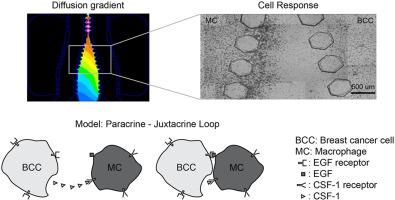Biomaterials ( IF 12.8 ) Pub Date : 2020-10-22 , DOI: 10.1016/j.biomaterials.2020.120412 Sevgi Onal 1 , Merve Turker-Burhan 2 , Gizem Bati-Ayaz 1 , Hamdullah Yanik 2 , Devrim Pesen-Okvur 2

|
Breast cancer cells (BCC) and macrophages are known to interact via epidermal growth factor (EGF) produced by macrophages and colony stimulating factor-1 (CSF-1) produced by BCC. Despite contradictory findings, this interaction is perceived as a paracrine loop. Further, the underlying mechanism of interaction remains unclear. Here, we investigated interactions of BCC with macrophages in 2D and 3D. While both BCC and macrophages showed invasion/chemotaxis to fetal bovine serum, only macrophages showed chemotaxis to BCC in custom designed 3D cell-on-a-chip devices. These results were in agreement with gradient simulation results and ELISA results showing that macrophage-derived-EGF was not secreted into macrophage-conditioned-medium. Live cell imaging of BCC in the presence and absence of iressa showed that macrophages but not macrophage-derived-matrix modulated adhesion and motility of BCC in 2D. 3D co-culture experiments in collagen and matrigel showed that BCC changed their multicellular organization in the presence of macrophages. In custom designed 3D co-culture cell-on-a-chip devices, macrophages promoted and reduced migration of BCC in collagen and matrigel, respectively. Furthermore, adherent but not suspended BCC endocytosed EGFR when in contact with macrophages. Collectively, our data revealed that macrophages showed chemotaxis towards BCC whereas BCC required direct contact to interact with macrophage-derived-EGF. Therefore, we propose that the interaction between cancer cells and macrophages is a paracrine-juxtacrine loop of CSF-1 and EGF, respectively.
中文翻译:

旁分泌-并列分泌环中的乳腺癌细胞和巨噬细胞
已知乳腺癌细胞 (BCC) 和巨噬细胞通过巨噬细胞产生的表皮生长因子 (EGF) 和 BCC 产生的集落刺激因子-1 (CSF-1) 相互作用。尽管发现相互矛盾,但这种相互作用被认为是一种旁分泌循环。此外,相互作用的潜在机制仍不清楚。在这里,我们在 2D 和 3D 中研究了 BCC 与巨噬细胞的相互作用。虽然 BCC 和巨噬细胞都显示出对胎牛血清的侵袭/趋化性,但在定制设计的 3D 片上细胞装置中,只有巨噬细胞显示出对 BCC 的趋化性。这些结果与梯度模拟结果和ELISA结果一致,表明巨噬细胞衍生的EGF没有分泌到巨噬细胞条件培养基中。在易瑞沙存在和不存在的情况下,BCC 的活细胞成像显示巨噬细胞而不是巨噬细胞衍生的基质在 2D 中调节了 BCC 的粘附和运动。胶原蛋白和基质胶的 3D 共培养实验表明,BCC 在巨噬细胞存在的情况下改变了它们的多细胞组织。在定制设计的 3D 共培养片上细胞设备中,巨噬细胞分别促进和减少 BCC 在胶原蛋白和基质胶中的迁移。此外,当与巨噬细胞接触时,粘附但未悬浮的 BCC 会内吞 EGFR。总的来说,我们的数据显示巨噬细胞对 BCC 表现出趋化性,而 BCC 需要直接接触才能与巨噬细胞衍生的 EGF 相互作用。因此,我们提出癌细胞和巨噬细胞之间的相互作用分别是 CSF-1 和 EGF 的旁分泌 - 并列分泌环。











































 京公网安备 11010802027423号
京公网安备 11010802027423号